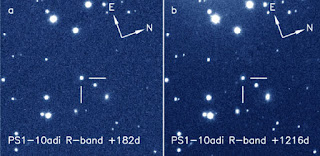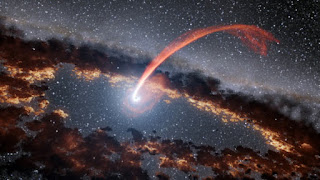An extremely energetic cosmic explosion happend on a very massive star or on the environment of a supermassive black hole. A paper reporting this discovery is published in the journal Nature Astronomy.
Using telescopes on La Palma and Hawaii, the astronomers detected an explosion that was so energetic it must have originated from one of two sources: (i) an extremely massive star — up to several hundred times more massive than our Sun — exploding as a supernova, or (ii) a lower mass star that has been shredded by the ultra-strong gravitational forces close to the supermassive black hole.
The event, dubbed PS1-10adi, occurred in the center of an active galaxy called SDSS J204244.74+153032.1, some 2.4 billion light-years from Earth.
“If these explosions are tidal disruption events — where a star gets sufficiently close to a supermassive black hole’s event horizon and is shredded by the strong gravitational forces — then its properties are such that it would be a brand new type of tidal disruption event,” said lead author Dr. Erkki Kankare, from Queen’s University Belfast, UK.
“If they are supernova explosions then their properties are more extreme than we have ever observed before, and are likely connected to the central environments of the host galaxies.”
 |
| PS1-10adi. Image credit: Pan-STARRS1 / Kankare et al. |
“The discovery we made has revealed explosions capable of releasing an amount of energy 10 times bigger than normal explosions,” added co-author Dr. Cosimo Inserra, from the University of Southampton, UK.
“Our data show that events like this are not very unusual and challenge our knowledge of exploding and disrupting stars.”
“At the same time, their existence provides us with important information about the extreme environment in the central, hidden, part of galaxies.”
“Now that we know what we are looking for, we are particularly excited that we will find more transients such as PS1-10adi in larger datasets from upcoming facilities,” said co-author Dr. Rubina Kotak, also from Queen’s University Belfast.
“This means that we are in a fantastic position to pin down their origin, and this will help to piece together more clues of how these events come about.”
E. Kankare et al. A population of highly energetic transient events in the centres of active galaxies. Nature Astronomy, published online November 13, 2017; doi: 10.1038/s41550-017-0290-2
Source: sci-news






No comments:
Post a Comment